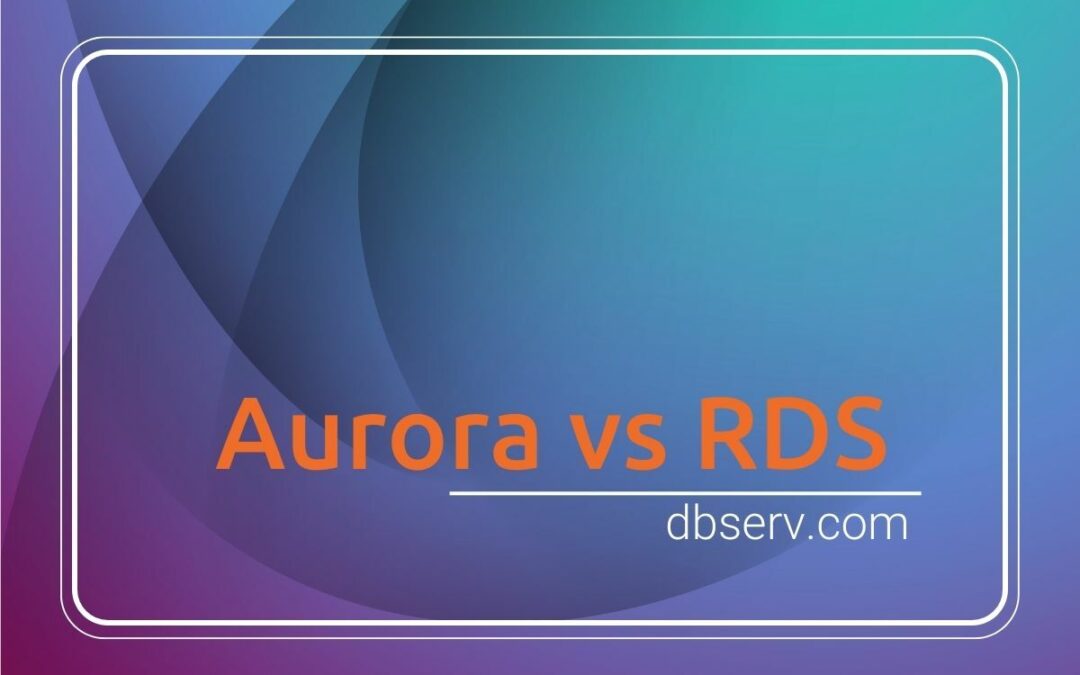According to MarketSplash statistics, over 400,000 developers use database software from Amazon Web Services (AWS). Many of them turn to Aurora and RDS. These databases are vital for effective management and storage of corporate information. However, they have some differences, so the question arises: which database suits your business?
DB Serv experts conducted a detailed comparison of Aurora vs RDS. Today you will learn the pros and cons of two popular Amazon products, as well as their characteristics, which will help you make an informed decision.
What is Amazon Aurora?
Amazon Aurora is a fully managed relational database designed for the cloud. It is compatible with MySQL and PostgreSQL database engines and has the following characteristics:
● High performance.
● Availability of high-quality AWS corporate database services.
● Reliability and security.
● Ease of use and cost-effectiveness.
The database also has its own Aurora Serverless configuration, enabling automatic scaling on demand.
Our Aurora vs RDS standoff begins with analyzing the advantages and disadvantages of the first database, and then we will introduce its opponent.
Pros of Amazon Aurora
✅ MySQL throughput is five times higher; PostgreSQL throughput is three times higher.
✅ Self-recovery capabilities and fault-tolerant cloud storage ensure maximum availability.
✅ Migration of local MySQL or PostgreSQL databases using dumps.
✅ Security is guaranteed by SSL encryption protocols and the presence of AWS Key Management Service (KMS).
✅ Amazon Aurora handles all management tasks, so users don’t need to install, configure, backup, and more on their own.
Cons of Amazon
❌ AuroraIt only supports compatibility with two databases.
❌ It uses only one storage engine, InnoDB, for data storage.
❌ It has limited resources and connections for small instances.
❌ Usually, it is more expensive than Amazon RDS for the same workload.
What is Amazon RDS
Amazon RDS (Relational Database Service) is a cloud-managed SQL (Structured Query Language) database service. It is compatible with five database engines: MySQL, PostgreSQL, MariaDB, Microsoft SQL Server, and Oracle. RDS also has a range of valuable features:
➡️ Ensures a high level of security.
➡️ Provides automatic software updates for the database.
➡️ Allows daily snapshots of database instances.
➡️ Creates backups by automatically setting the backup time.
Amazon Aurora vs RDS: Let’s take a closer look at the main pros and cons of the Relational Database Service.
Pros of Amazon RDS
✅ Supports five database engines.
✅ Has simplified disaster recovery and easy scalability compared to local databases.
✅ High data security during storage and transmission thanks to SSL protocols and KMS.
✅ Numerous automatic features: backup, failover, memory allocation, additional storage.
✅ Synchronous copy of replicas in other availability zones thanks to the Multi-AZ feature.
Cons of Amazon RDS
❌ It supports only five read replicas.
❌ It lacks automatic optimization and performance tuning.
❌ It encounters difficulties with automatic data compression.
❌ There is no root access to the server, and processor and storage performance are not guaranteed.
Aurora vs RDS: Key Differences
Let’s delve into the characteristics of the cloud database services Aurora and RDS, focusing on key aspects. Thus, we will get a comprehensive comparative analysis.
Architecture Design
The architecture in RDS resembles the engine installation of one of Amazon’s infrastructure services, Elastic Compute Cloud, but AWS handles the provisioning and maintenance. RDS uses Amazon EBS volumes and offers the Multi-AZ feature, significantly enhancing the reliability of database storage and logs.
Aurora’s structure resembles a traditional DBMS, using most of its standard components. However, it incorporates its own innovations, including data replication to remote storage and storing only changelogs on a remote disk. This significantly enhances database availability and scalability. Furthermore, data in Aurora is replicated six times across three availability zones, with the database storage separated from instances. All of these factors ensure a high level of fault tolerance and reliability.
Performance
The Relational Database Service utilizes solid-state drives to improve input/output operations performance. Data storage devices are optimized (for high loads in Online Transaction Processing applications) and cost-effective (for general-purpose use).
Compatibility with Database Engine
Thanks to compatibility, you can run your database apps on RDS and Aurora without modifications. However, note that RDS supports five database engines: MySQL, PostgreSQL, MariaDB, Microsoft SQL Server, and Oracle. In contrast, Aurora only works with PostgreSQL and MySQL engines.
Availability and Durability
The data storage model in Aurora, along with continuous backup, provides higher reliability and availability than Amazon RDS. Aurora clusters consist of six data storage nodes distributed across three availability zones. If one zone goes down, the data is copied and becomes available for operation in the other two zones.
As a result, you won’t need to deploy many replicas, as is the case with RDS. Therefore, Relational Database Service loses in the AWS Aurora vs RDS comparison in terms of data durability and redundancy.
Resiliency
RDS has a clear disaster recovery process. Users can manage it from the command-line interface or console. This allows for database recovery down to the second, minimizing data loss. However, the downside is that this operation takes much time and is primarily done manually. Therefore, there’s a risk of errors due to a human factor.
Aurora is more resilient and also recovers quickly after a failure. Computational nodes that fail are replaced almost instantly because new read replicas can be launched with minimal delay without waiting for the coordination of other nodes.
Scalability
Both AWS products let you scale memory and computational resources vertically. The maximum specifications for both databases reach 244 GB of RAM and 32 vCPUs.
Storage
RDS storage can automatically scale its capacity up to 64 terabytes for all compatible databases. The only exception is SQL Server, where only 16 TB is available. RDS also offers the Storage Auto Scaling feature, allowing you to set a storage limit that will automatically adjust to your database’s needs with minimal downtime.
Aurora’s storage can also automatically increase its capacity according to your preferences, with a minimum expansion of 10 GB and a maximum of 128 TB.
Replication
As we explore the Aurora vs RDS topic, let’s look at how many replicas each service offers. Relational Database Service (RDS) gives users five replicas, and the replication process is somewhat slower compared to its counterpart.
On the other hand, Amazon Aurora offers 15 replicas that take a few milliseconds to implement. New read replicas are also added to the service faster than in RDS due to rapid scaling.
Failover and Backup
In RDS, failover is a manual process done by the user, which can potentially lead to data loss. However, it’s worth noting that using the Multi-AZ feature for failover in case of an outage helps minimize risks, eliminate downtime, and maximize reliability. Amazon RDS also lets you create daily database snapshots during your chosen backup window.
Failover in the Aurora service is entirely automated, resulting in minimal data loss risk. Furthermore, automation makes the failover process much quicker than in RDS. Aurora also offers incremental and automatic backups, reducing the need for frequent database snapshots. Both services store backup copies on Amazon S3.
Cluster Endpoints
In RDS, the cluster endpoint is a DNS endpoint that points to the current instance of your primary database and is used for write requests. The service redirects this endpoint to another device during failover by making DNS changes. Additionally, you’ll need to manage the load on your database for read replicas using this endpoint because RDS doesn’t have a dedicated load balancer for this operation.
In Aurora, the cluster endpoint, like its counterpart, is also used for write requests. The read endpoint handles the load balancing for read replicas in the service.
Pricing
When comparing AWS Aurora vs RDS, it’s essential to consider the cost. Aurora tends to be slightly more expensive than RDS, as its pricing is based on the instance size and the number of input/output operations. Both products charge for storage based on actual usage. However, RDS offers a free trial period.
Aurora vs RDS: What to Choose?
So, who emerges victorious in the Aurora vs RDS showdown? It’s not an easy answer since both AWS products have their strengths and weaknesses and can be applied in various industries. Aurora is a great choice for companies using high-demand, high-availability databases with intensive workloads and reading.
RDS only suits businesses with database engines like MariaDB, Microsoft SQL Server, or Oracle. This service is also the better choice for those seeking a more cost-effective but still secure solution.
Conclusion
Take a look at our comparison table, where we’ve summarized the key differences. It will help you make an informed decision in the Aurora vs RDS debate.
Aurora
Supported Databases: MySQL, PostgreSQL.
Scalability: Both services can scale up to 244 GB of RAM and 32 vCPUs.
Performance: MySQL throughput increases by 5 times, and for PostgreSQL, it’s 3 times.
Storage: Minimum increase is 10 GB, with a maximum of 128 TB.
Replication: Supports up to 15 read replicas.
Cost: Pricing is based on the number of input/output operations.
RDS
Supported Databases: MySQL, PostgreSQL, MariaDB, Microsoft SQL Server, and Oracle.
Scalability: Both services can scale up to 244 GB of RAM and 32 vCPUs.
Performance: Utilizes two types of solid-state drives (SSDs) to enhance performance.
Storage: Maximum capacity is 64 TB, except for SQL Server, which is 16 TB.
Replication: Supports only up to 5 replicas.
Cost: Offers a free testing version.
Still unsure about your choice of managed database service? Turn to the experts at DB Serv. We are ready to provide comprehensive consultation on Amazon RDS and AWS Aurora services.
We’ll help you find the best fit for your business needs!

